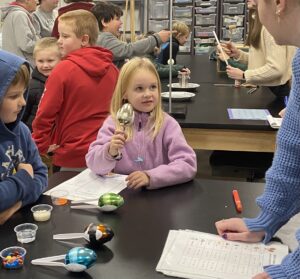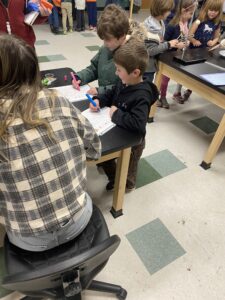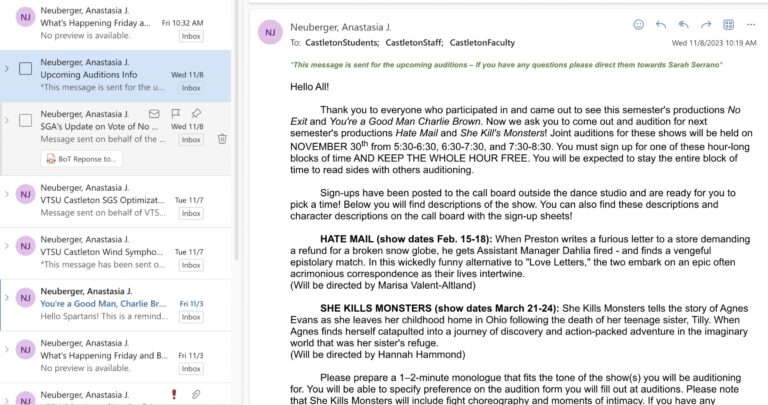First-graders learn about physics

On Friday, Nov. 3, Castleton Elementary first graders swarmed the Physics for Elementary Teachers class in collaboration with Vermont State University Castleton education majors for interactive science activities.
“Can you see sound waves?” posed freshman Mikey Rabi, presenting about sound waves using cup phones, slinkies, and different levels of water in a glass.
“I can see one right by head!” exclaimed a first-grade boy.
“It’s his hair,” cleverly responded another girl.
The 15 students in professor Tim Thibedeau’s physics class had one week to come up with their own original ideas of how to present sound and light waves to the group of 35 children. Upon presentation time, children filtered through the stations in small groups, for a few minutes each.
For instance, the student puppet activity, hosted by Grace Gardner and Skylar Larabee, was a hit for first grader, Levi.
Or Karsen Dunican’s activity of hitting a tuning fork to see how it interacts with the water, was named their favorite by James and TJ.
Other activities included drawing pictures of how a paint brush is visually distorted when put in water, using crafted harmonicas, and playing the game Red Light Green Light using a flashlight and colored gels.
Kate Molis, grade one teacher at Castleton Elementary, said one of her main focuses has been “to engage with the community more,” and that events like these are a great way to do it.
“The kids are so engaged,” said Molis, “and they get to go to places they don’t usually go to.”
Looking around the room, evidently the children were fascinated by every one of the activities. It got them up and moving, whether in the hallway to talk through cup-phones, or shaking plastic eggs filled with different materials, like pasta or rice, to hear the sound it makes.

activities with VTSU Castleton students.
“Are you ready?” asked one boy.
“Let’s make some music!” he exclaimed, showcasing his best dance moves.
Students of the class were similarly excited for the event. For Rabi, it was a lot of fun, especially with it being his first time teaching in a classroom. For others, like senior Alyssa Ferris, “it gives [her] a glimpse of what life will be like next year.”
Since 2017, Thibedeau has incorporated elementary school collaboration into his class, naming Rutland Intermediate, Barstow Memorial School, and Castleton Elementary. Each year they try to have two to three visiting groups of students.
“These events are important for lots of reasons,” said Thibedeau. “First, our future teachers need to learn how to teach science. This course, through these visits, gives prospective educators the opportunity to plan, deliver, and reflect on real science teacher early in their studies.”
He believes a key strength of the Education program is how they prioritize the teaching of all disciplines, beyond standard math and literacy.
“But I think it is the elementary students who get the most out of the visit,” he continued. “Schools and teachers are doing their best with what they have, but they don’t have everything. We have a well-stocked lab, and we can provide many activities local schools can’t.”
He says that there is “nothing more inspiring” than seeing the kids participate, even asking their teachers afterwards to do more experiments or science fairs at school.
“I truly hope we can do more of this in the future. We will continue to offer Physics for Elementary Teachers on a yearly basis, and I plan to welcome students into our classroom each time.”








